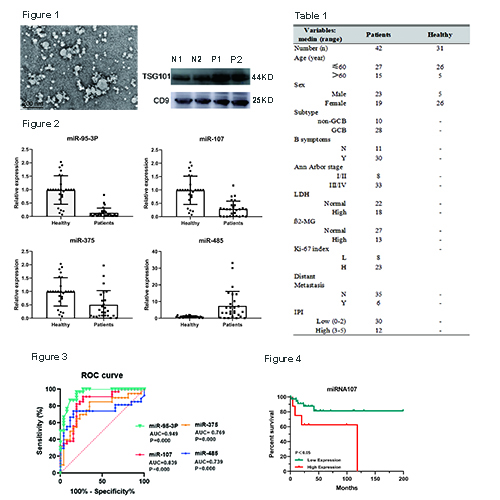
Contributions
Abstract: EP868
Type: E-Poster Presentation
Session title: Lymphoma Biology & Translational Research
Background
Diffuse large B-cell lymphoma (DLBCL) is an aggressive malignant lymphoma with high heterogeneity, which bring great difficulties to precise diagnosis and prognosis. Circulation exosomal miRNAs have emerging as complementary biomarkers and exserted as new opportunities to develop non-invasive tests for early diagnosis or follow-up of disease. Accumulating evidence suggested that miR-107 played a critical role in suppressing tumorigenesis. However, the significance of exosomal miR-107 in DLBCL is still not well understood.
Aims
The aim of this study is to explore the serum exosomal microRNAs to be novel biomarkers as well as therapeutic targets for DLBCL.
Methods
Differentially expressed microRNAs (DEMs) involved in DLBCL progression were screened from Gene Expression Omnibus (GEO) database (GSE117063 and GSE29493). Serum-derived exosomes were isolated by Qiagen ExoEasy Maxi Kit. Transmission electron microscopy (TEM) and Western blot were performed to examine the exosomal characteristics. Quantitative real-time PCR (qRT-PCR) was applied to determine the serum exosomal expression levels of microRNAs from 42 DLBCL patients and 31 normal samples. Kaplan-Meier analysis, and ROC working curve analyses were performed to assess the diagnostic and prognostic values of exosomal miRNAs in DLBCL patients.
Results
A total of 14 DEMs in DLBCL were identified from the GSE117063 and GSE29493 datasets. Serum-derived exosomes were isolated from 42 patients and 31 healthy volunteers, and the characteristics of patients were subscribed in Table 1. TEM and western blot for Tsg101 and CD9 are consistent with previous description of exosomes (Figure 1). Among the identified DEMs,3 down-regulated miRNAs (miR-95-3P, miR-107, miR-375) and 1 up-regulated miRNA (miR-485) were verified to be significantly differently expressed in DLBCL patients (Figure2). ROC curve analyses revealed that these serum exosomal miRNAs, miR-95-3p, miR-107, miR-375, and miR-485, acted as potential biomarkers for DLBCL, with the AUC of were 0.94, 0.839, 0.769 and 0.739, respectively (Figure 3). In addition, Kaplan-Meier analysis of the TCGA database indicated that compared to the control group, DLBCL patients with low-expression of miR-107 presented worse prognosis (Figure 4), suggesting that miR-107 may be a prognostic factor for DLBCL.

Conclusion
In this study, we demonstrate for the first time that serum exosomal miRNAs, such as miRNA-107, could be applied as non-invasive novel diagnostic and prognostic biomarker in DLBCL. With further research we expect that miR-107 to be a promising therapeutic target for DLBCL.
Keyword(s):
Abstract: EP868
Type: E-Poster Presentation
Session title: Lymphoma Biology & Translational Research
Background
Diffuse large B-cell lymphoma (DLBCL) is an aggressive malignant lymphoma with high heterogeneity, which bring great difficulties to precise diagnosis and prognosis. Circulation exosomal miRNAs have emerging as complementary biomarkers and exserted as new opportunities to develop non-invasive tests for early diagnosis or follow-up of disease. Accumulating evidence suggested that miR-107 played a critical role in suppressing tumorigenesis. However, the significance of exosomal miR-107 in DLBCL is still not well understood.
Aims
The aim of this study is to explore the serum exosomal microRNAs to be novel biomarkers as well as therapeutic targets for DLBCL.
Methods
Differentially expressed microRNAs (DEMs) involved in DLBCL progression were screened from Gene Expression Omnibus (GEO) database (GSE117063 and GSE29493). Serum-derived exosomes were isolated by Qiagen ExoEasy Maxi Kit. Transmission electron microscopy (TEM) and Western blot were performed to examine the exosomal characteristics. Quantitative real-time PCR (qRT-PCR) was applied to determine the serum exosomal expression levels of microRNAs from 42 DLBCL patients and 31 normal samples. Kaplan-Meier analysis, and ROC working curve analyses were performed to assess the diagnostic and prognostic values of exosomal miRNAs in DLBCL patients.
Results
A total of 14 DEMs in DLBCL were identified from the GSE117063 and GSE29493 datasets. Serum-derived exosomes were isolated from 42 patients and 31 healthy volunteers, and the characteristics of patients were subscribed in Table 1. TEM and western blot for Tsg101 and CD9 are consistent with previous description of exosomes (Figure 1). Among the identified DEMs,3 down-regulated miRNAs (miR-95-3P, miR-107, miR-375) and 1 up-regulated miRNA (miR-485) were verified to be significantly differently expressed in DLBCL patients (Figure2). ROC curve analyses revealed that these serum exosomal miRNAs, miR-95-3p, miR-107, miR-375, and miR-485, acted as potential biomarkers for DLBCL, with the AUC of were 0.94, 0.839, 0.769 and 0.739, respectively (Figure 3). In addition, Kaplan-Meier analysis of the TCGA database indicated that compared to the control group, DLBCL patients with low-expression of miR-107 presented worse prognosis (Figure 4), suggesting that miR-107 may be a prognostic factor for DLBCL.

Conclusion
In this study, we demonstrate for the first time that serum exosomal miRNAs, such as miRNA-107, could be applied as non-invasive novel diagnostic and prognostic biomarker in DLBCL. With further research we expect that miR-107 to be a promising therapeutic target for DLBCL.
Keyword(s):


